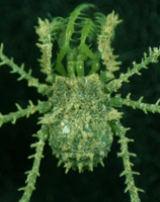
Grassatores
Encyclopedia
Grassatores is the most diverse infraorder of the Laniatores
. It includes over 3,500 species distributed mainly in the World Tropics
(Kury, 2003). They are characterized by the male genitalia without musculature, operated by hydraulic pressure and by the double tarsal claws of posterior legs.
Laniatores
Laniatores is the largest suborder of the arachnid order Opiliones with over 4,000 described species worldwide. The majority of the species are highly dependent on humid environments and usually correlated with tropical and temperate forest habitats....
. It includes over 3,500 species distributed mainly in the World Tropics
Tropics
The tropics is a region of the Earth surrounding the Equator. It is limited in latitude by the Tropic of Cancer in the northern hemisphere at approximately N and the Tropic of Capricorn in the southern hemisphere at S; these latitudes correspond to the axial tilt of the Earth...
(Kury, 2003). They are characterized by the male genitalia without musculature, operated by hydraulic pressure and by the double tarsal claws of posterior legs.
Superfamilies included
- Superfamily Epedanoidea Sørensen, 1886
- Superfamily PhalangodoideaPhalangodoideaPhalangodoidea is a superfamily of the harvestman infraorder Grassatores with three recognized families and 220 species. It is not to be confused with the similar spelled subfamily Phalangioidea, which is also a harvestman superfamily, but within the infraorder Eupnoi.-Families:* Oncopodidae...
Simon, 1879 - Superfamily SamooideaSamooideaSamooidea is a large superfamily in the Grassatores group of harvestmen. It includes around 380 species distributed throughout the tropics. They are characterized by the complex male genitalia, with eversible complementary sclerites....
Sørensen, 1886 - Superfamily Zalmoxoidea Sørensen, 1886
- Superfamily GonyleptoideaGonyleptoideaGonyleptoidea is the most diverse superfamily of the Grassatores. It includes around 2,500 species distributed in the tropics. They are characterized by the simplified male genitalia, with the glans free subapical in the truncus....
Sundevall, 1833
External links
- Classification of Opiliones A synoptic taxonomic arrangement of the order Opiliones, down to family-group level, including some photos of the families

